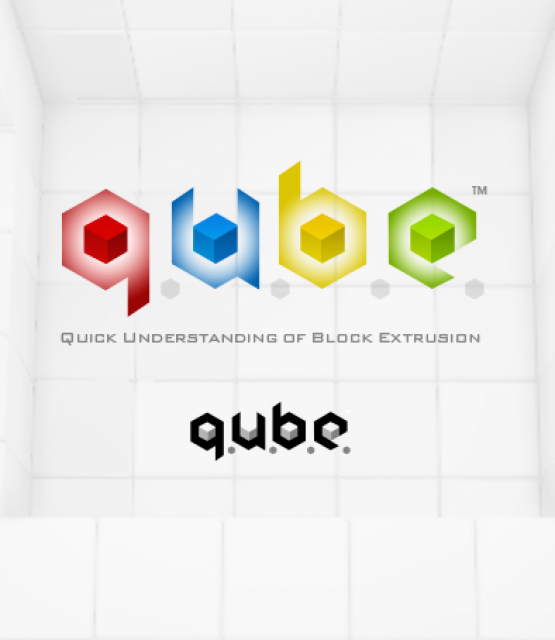Comparisons can be made, but it's mostly in appearance.
I have seen many people compare Q.U.B.E. to the Portal franchise. While I can see why they are made, I feel that this is merely in how the game it looks. Its motives for Portal style trappings are there, but the game only travels shortly down that path. Instead I feel we were left with something more straightforward and lacking in narrative.
Q.U.B.E. starts strong with its easy to manage puzzle room and hallway structure. But as you go on, the emphasis on physics in the puzzles disrupts your logic solving mentality and replaces it with trial and error. You are left hoping that objects land in just such a way so you can continue, or else be stuck there for too long.
The backbone of the game involves three color groups of blocks that form either stairs, a spring, or a pillar, most with varying states of block length. It's simple, effective, and can be expanded on as the game adds more elements involving those core block types.
The puzzles begin traversal only followed by simple push block puzzles that are used to grant you the extra step forward out of the puzzle room. They then swap the block with a rolling ball that triggers the way forward, and after that implement coloring the ball to trigger specific colored areas. After all that, they throw you into darkness, where you must use light switches to see the locations of the colored blocks in the dark room or hallway. These early puzzles are the best of the lot. The groundwork they set still works and these puzzles won't take you too many attempts to solve.
The block puzzles are easy to remember, and fun to meddle with on your way to a solution. The better puzzles are at the beginning where physics aren't much of a priority.
In later stages, the Portal comparisons can really be made as you find the once clean block puzzle prison dilapidating around you. The puzzles start to really leave their territory in these parts: Blocks needing you to touch physics infused hanging wires to re-power them for interaction, mazes of core colored blocks you can manipulate to escort path finding orbs, rotating mirrors and positioning relay boxes in 3D rooms to redirect beams of light. These just don't feel like the same game I started with. They use those core colored block types, but even then you're not platforming in the room; half of these puzzle types are behind glass as you manipulate from a far. They're not all bad puzzles, but they're not what I was expecting when I started.
Relying on physics for block placement makes certain areas frustrating and evoked too much trial and error puzzle resets. If you’re off even a bit, blocks can catch on a corner and get misaligned, causing more grief than you would like.
The very last set of puzzles bring back the fundamentals at the start of the game and let you place a game dictated set of colored block types onto glowing surfaces. You can place a spring block and use it to jump to a ledge, or set down a set of stairs blocks. You can also rotate a section of the wall, clear the block type, and place down a different set in the newly rotated spot. You will be forced to think differently about those original rule types in an effort to navigate a puzzle room. Namely the last puzzle climb, which took me a while to figure out, but I did it of my accord and not because something was a foot off its needed position.
A more defined narrative would help motivate me more. One of the examples being dialogue. Also, preventing physics from messing with the ease of your puzzles. If a block doesn't need to rotate 5°, then lock it at its current angle.
Maybe it’s harsh for me to hope for a more grandiose story in this title, but when this game draws so many comparisons to Portal, it's hard not to. The game's developers, Toxic Games, originally had plans for a true narrative but it ultimately was cut, which is a shame. Though, the game is all sorts of confused with itself. From block puzzles, to light puzzles, to magnet puzzles, and back to block puzzles, it took quite the roller coaster ride for me. The game did start out as a student assignment, so I do see where they were coming from with the overload of mechanics. In the end though, I felt mixed on the experience. It was an interesting game and project, and I hope to see more from these guys.
